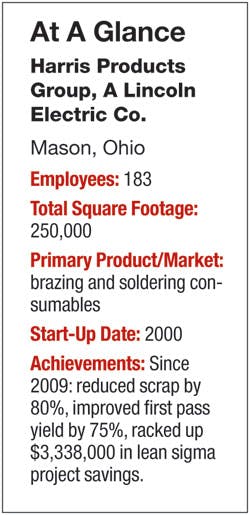As workers file in through the hallway overlooking the plant floor at Harris Product Group's Mason, Ohio, facility, they are privy to an endless array of data.
The walls of the corridor are plastered with charts and graphs detailing all of the plant's vital performance stats, allowing workers coming in for a shift to check the plant's fill rates and profitability reports, even their managers' weekly 5S ratings. And of course there is the little matter of scrap rates -- a chart the staff has enjoyed watching plummet for the past three years.
Since 2009, when these displays first started popping up, the company has seen steady, relentless improvement. From the 45% decrease in WIP to the 41% drop in customer reject rate and inching up toward a 90% first pass yield, the company's numbers are breaking records, shattering expectations and yielding industry best results.
While it was no easy task to turn around the ingrained inefficiencies of a century-old company, Robert Temple, plant manager and lean champion at Harris, says the company had no choice but to take it on. Because Harris had such a strong standing in the industry, "we knew we could do 'good enough' and stay in business for another hundred years," he says. "But when the recession hit and our competitors started to fail, we knew we had to do something more."
That "something more" meant fundamentally transforming the processes of the entire plant into a lean, cooperative network for efficiency. The first step of that process was to take a closer look at what exactly the company was already doing.
"From my vantage point, there has been a huge evolution of how we do business here at the plant," says CEO Nangle. "We started to document some of the things that we did and realized that while we thought we were really good, we could be much better. That's when the journey began."
Discovering the Real Cost of Scrap
Nowhere has this played out more dramatically than its handling of scrap.
The copper and silver the Mason facility melts into its finished products can represent as much as 97% of its total materials costs, yet historically very little attention has been paid to how much of it was scrapped in day to day operation. "All of the scrap we produce is remelted," explains Nangle. "Since the price of copper and silver was going up, the thinking was that the scrap we redid could actually make us money."
That logic, however, did not factor in labor or energy costs, which, compounded through the remelting process, far offset any potential gains.
Since they began collecting and working from data, Harris' casting team has "changed every paradigm in that department of what engineering scrap was about," says Nangle, utilizing advanced metallurgical tools and going through a lot of experiments and projects.
By focusing on casting and scrap, and using data to guide them, the casting team has reduced scrap by some 80% since 2009, adding up to an impressive $1.23 million in project savings from that department alone.
"Data is driving everything," Temple notes. "We are challenging legacy processes, improving quality, improving efficiency. Data is how we get there."
For more on the 2012 Best Plants winners' amazing achievements, click here.




